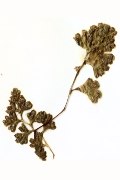Ferns - native
Fern habitat. There is a surprisingly large list of ferns for the district. Fern habitat includes water races and seepage from water races. Four species have only been recorded from mine shafts. Almost all of the wet-area fern records are from before 1990, and these ferns may well be extinct locally.
Fronds. The leaves of ferns are called fronds. Fronds may be simple (undivided), clover-like, branched, or pinnate (divided into leaflets). The leaflets may themselves be divided (2-pinnate), which may be again divided (3-pinnate) which may be further divided (4-pinnate).
Life cycle. Ferns have a two stage life cycle. In the sexual stage the small, usually heart-shaped plant produces male and female cells, which may fuse to form the embryo. The embryo grows to form roots and leaves The original sexual plant soon dies. The fern in this second stage reproduces by means of spores. The spores may be prodced by tiny structures near the roots (as in nardoos), or from the backs of the leaves.
Fertile and infertile fronds. Fronds that produce spores are said to be fertile. Infertile fronds (or barren fronds) do not produce spores. Some ferns (e.g. water ferns and adders tongues) have fertile fronds which are a different shape to the infertile fronds.
Underground stems. Many ferns have underground stems (called rhizomes). The fronds grow from the rhizomes. The rhizome may be horizontal and spreading (as in bracken), or erect, so that the fronds are tufted. In some ferns the rhizome is above ground.
 Pacific Azolla (Azolla filiculoides) Floating fern with divided fronds. Floats on still water.
Pacific Azolla (Azolla filiculoides) Floating fern with divided fronds. Floats on still water. Rock Ferns (Cheilanthes species) Small ferns. Dry forests.
Rock Ferns (Cheilanthes species) Small ferns. Dry forests.  Nardoo (Marsilea drummondii) Leaves like 4-leaved clover.
Nardoo (Marsilea drummondii) Leaves like 4-leaved clover. Bracken Fern (Pteridium esculentum) Medium fern. Can form dense patches.
Bracken Fern (Pteridium esculentum) Medium fern. Can form dense patches. Bracken-like Ferns Medium ferns. Fronds 2 or 3-pinnate.
Bracken-like Ferns Medium ferns. Fronds 2 or 3-pinnate.  Sickle Fern (Pellaea falcata) Fronds 2-pinnate. Leaflets small, sparse. Rare.
Sickle Fern (Pellaea falcata) Fronds 2-pinnate. Leaflets small, sparse. Rare. Maidenhair Fern (Adiantum aethiopicum) Triangular leaves. Narrow leaf stalks.
Maidenhair Fern (Adiantum aethiopicum) Triangular leaves. Narrow leaf stalks.  Necklace Fern (Asplenium flabellifolium) Delicate light-green fan-shaped fronds.
Necklace Fern (Asplenium flabellifolium) Delicate light-green fan-shaped fronds.  Soft Tree-fern (Dicksonia antarctica) Tree fern. Fronds taper both ends. Rare.
Soft Tree-fern (Dicksonia antarctica) Tree fern. Fronds taper both ends. Rare.  Austral Adder's-tongue (Ophioglossum lusitanicum) 1 or 2 leaves at base and fertile terminal frond. Rare.
Austral Adder's-tongue (Ophioglossum lusitanicum) 1 or 2 leaves at base and fertile terminal frond. Rare. Scrambling Coral-fern (Gleichenia microphylla) Fronds repeatedly branch. Rare.
Scrambling Coral-fern (Gleichenia microphylla) Fronds repeatedly branch. Rare. Blanket Fern (Pleurosorus rutifolius) Small triangular fronds are hairy. Moderately common.
Blanket Fern (Pleurosorus rutifolius) Small triangular fronds are hairy. Moderately common. Water Ferns and Rasp Fern (Blechnum) Medium ferns. Fronds 2-pinnate. Rare.
Water Ferns and Rasp Fern (Blechnum) Medium ferns. Fronds 2-pinnate. Rare. Annual Fern (Anogramma leptophylla) Tiny fern, under 5cm. Leaves soft, thin. Rare.
Annual Fern (Anogramma leptophylla) Tiny fern, under 5cm. Leaves soft, thin. Rare. Quillwort (Isoetes drummondii) Small grass-like fern. Wet areas. Rare.
Quillwort (Isoetes drummondii) Small grass-like fern. Wet areas. Rare.